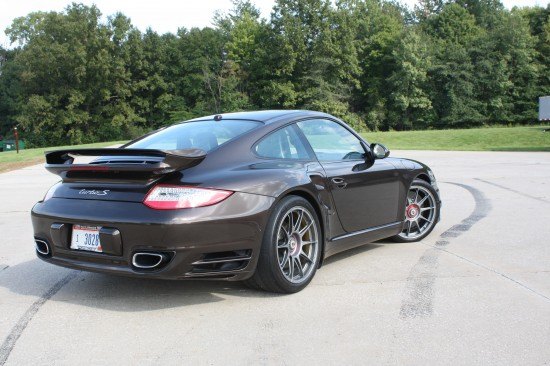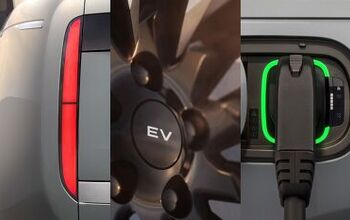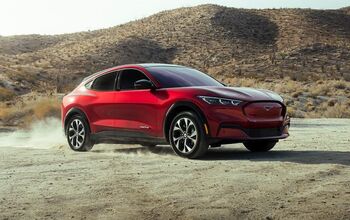Review: 2011 Porsche 911 Turbo S PDK

Good news, everybody! All that drama with the nice people at Porsche is totally over! Here’s how the phone conversation went:
*ringgggg*
Jack: STOP CALLING ME! It isn’t mine! I had a vasectomy! I told you beforehand! YOU SAW THE SCARS!
Unknown Caller: Jack, this is Gary Fong, from Porsche Cars North America.
Jack: What can I do for you, Mr. Fong?
Gary Fong: Jack, we want to put this all behind us. All us guys at the office put our heads together and decided that a guy who owns three of our cars, has put hundreds of racetrack laps on Porsches, has served as a driving instructor for dozens of Porsche owners, and has over a million readers every single month of the year deserves at least as much press access as, say, raw-dog random blogs with one comment per article. We’re going to start you off with one of the crown jewels in our lineup: the 2011 911 Turbo S. In Macadamia Brown, of course, and with a sticker of $186,985.
Jack: Gary, I feel this marks a new era of trust and cooperation between our companies, and the real winner of this will be our valued readers.
Gary: Jack, I couldn’t agree more. It isn’t about fluffing moronic racetrack oilers or providing free business-class air travel to people who couldn’t hold up the ass end of a pre-school bicycle rodeo. It’s about making sure Porsche fans, and customers, everywhere, learn the truth about our cars.
I was humbled by Porsche’s decision. And as I stepped out of my white 993 and prepared to experience the 911 Turbo S for the first time, I realized something:
The above scenario will never fucking happen in zillion years. Thank God for Dr. Sanjay Mehta and Larry Woo of RH Motorcars, the buyer and seller, respectively, of this extremely expensive and precious turbocharged Porsche; they were willing to let me take it out and run it up to triple digits. TTAC readers know Dr. Sanjay pretty well, of course, but Mr. Woo will be new to almost all of you. RH has an utterly fascinating inventory, ranging from delivery-mileage Testarossas to brand-new 458 Italias to the original street-spec slant-nose Porsche DP935. If you want to see more tests of RH’s inventory here in TTAC, take a moment to let Mr. Woo know. It’s only a 265-mile roundtrip for me to visit their main showroom and I’m willing to make that trip as often as required. Alright, enough thanking the sponsors, let’s drive the car.
What is a 911 Turbo S? Along with the infamous GT3 RS 4.0, the Turbo S represents about the last possible extension of the 997-generation Porsche. It’s a very, very rapid car. The color rags are obtaining quarter-mile times of 10.7 and 10.8 seconds, with trap speeds of 128-130mph. Even in a the current era of hyper-fast production cars, that should make you sit up and take notice. Thanks to the PDK transmission and four-wheel-drive, you’ll reach the quarter-mile mark ahead of the Carrera GT, McLaren F1, and Ferrari Enzo, although all of them will sail by some time afterwards thanks to superior aerodynamics.
Nominally speaking, the Turbo S isn’t the fastest 911 I’ve driven; that would be the Switzer GT2 P800, an 815-horsepower, rear-wheel-drive monster that once memorably bopped the ‘170’ mark on the speedometer as I was entering the mild kink on BeaveRun’s back straight. Unfortunately, nontrivial turbo lag and traction issues hamper the monstrous Switzer until third gear, and even then it’s a good idea to save checking your GChat convos until you’ve grabbed fifth and cleared one-fifty or so. I had the car step out on me once when we were already doing double the Ohio freeway speed limit.
The 997 Turbo S has no such issues. This is what I did: from a nice 5mph roll, I selected first gear in the PDK. After lo these many years, Porsche has finally fitted proper paddle shifters to the 911. No more thumbing your way through the gears. Larry gave me the go-ahead, and I engaged full throttle. The response was instantaneous and head-snapping. The road we’d selected was a narrow industrial-park blind alley which was made by laying thirty-foot concrete slabs end to end. The Turbo reached sixty in what seemed like four of them, bouncing madly around as the wheels lost and gained traction over each uneven gap. Time to shift.
Behold the magic of PDK: it works just as well behind a 530-horsepower Porsche as it does behind a 200-horse GTI. (And probably breaks just as often, but that’s a story for another time.) There was no discernible loss of thrust as the next gear clicked in. My mind had reset into FAST CAR MODE by then after two hours spent driving up in my relatively poky (13.8s quarter-mile) 993, so I had plenty of time to think about grabbing third. By the time I needed fourth, there was a rather large tractor-trailer swelling in the windshield, so I said to Larry, “I’m going to stop the car,” and I stopped it.
I’d never want to pay the replacement tab for Porsche’s carbon-ceramic brakes, but the current ones have a pedal feel best described as “stepping on a steel block mounted on hydraulic rams.” In a few squeaks of the ABS we were motionless once again. Hell of a car.
Make no mistake; you would get used to the power eventually, the same way riders of Kawasaki’s ZX-12 all eventually decide to put nitrous bottles on the thing. My experience driving a few 800-plus-horsepower cars around sunny Powell, Ohio has taught me that there are actually plenty of places to rip out a quick 0-150 everywhere you look, even in suburbia. Your mileage, and ability to survive hitting a tree at warp speed, may vary.
The rest of the 911 Turbo S, excepting the very swank OZ center-lock wheels fitted to our test car, is standard Porsche. That means you’re paying $186,985 for a car that isn’t all that distinguishable inside from a $45,000 Boxster. This particular Turbo S had twenty-six grand worth of options. I uploaded the below picture at full-res so you can read them all.
Some of the highlights:
- Leather bezel for navigation system: $2,225.
- Changing the color of the stitiching on the seats: $1,100.
- Special Cocoa leather: $430. I just want to point out that the “special Cocoa leather” was standard equipment on my Boxster S 550, which was modestly priced at $61,310. Nice of Porsche to charge extra for the stuff on a Turbo that bases at $160K.
- Clear turn signals on the taillamps:$610. This is because clear plastic costs hundreds of dollars per square inch. Or at least it does in Willy Wonka’s Porsche Factory.
Good stuff, and Dr. Mehta will no doubt find that having a leather bezel on his nav system totally eases the kind of stress you feel after spending a whole day killing tumors with laser beams. You have no idea how often it’s pissed me off that my 993 has plastic surrounding the nav system. Actually, it’s plastic surrounding the area where the nav system would be if such a thing had been available. On my car, that area is reserved for… um, nothing. Just a totally empty space. Once upon a time, Porsches didn’t have “full consoles”. Example photo:
This above interior was considered quite the candy-ass thing by people who had this interior in their Seventies 911s:
I think they used the same shifter in the Chevy LUV.
Back to our Turbo S. What else can I tell you about it? It’s remarkably quiet, even given the Tubi aftermarket exhaust fitted to this model. The leaned-back windscreen in the current 997 really kills the wind noise compared to the old cars. The 997 interior, all jokes aside, is a tremendous improvement over the dismal 996 cabin. At the very limit, the Turbo S defaults to understeer. ( Wink.) There isn’t much trunk space, because the front differential eats it all. Get a 911 GT2 if you need to carry large objects.
Naturally, I was charmed by the twin-blown S and was pleased that Dr. Mehta decided to make it a 40th birthday present to himself. (For my 40th birthday, which comes up any day now, I’m going to super-size lunch at McDonald’s and luxuriate in the additional volume of french fries.) There are really only two things about which I would like to quibble.
First, the price. It’s ridiculous for a car that shares most of its architecture with the Boxster to cost this much. Either the 911 Turbo is a ripoff, or the Boxster is subsidized heavily by Turbo profits. I bet you it isn’t the latter. The used market isn’t supporting Turbo prices the way it used to, and the used Porsche market is a very savvy market. Once upon a time, the Turbo cost way more because the engine cost way more, but that’s no longer the case…
…which brings me to Quibble #2. Until the “997.2”, all watercooled 911 Turbos had the old split-case GT1 engine that Switzer and others have regularly pushed past the 1000-horsepower mark on stock internals. It’s one of the great engines of this or any other time, and I’ve put a micrometer on disassembled ones myself and marveled at the craftsmanship. The 997.2, however, has a direct-injected 3.8-liter variant of the standard Carrera engine. No more thousand-horsepower tunes, no more ten thousand racetrack miles between oil changes, no more season after season of vicious abuse without so much as a whimper. In the standard Carrera, which had been afflicted for over a decade with suicidal garbage engines possessing the deranged delicacy of Natalie Portman’s character in “The Black Swan”, the new mill is a blessing; in the Turbo, it ain’t. More worryingly, it raises the possibility that somebody with access to Craiglist and TPC’s phone number can spend $45,000 and blow your brand-new 997 Turbo S away using an ’03 996 Turbo and a mid-range tune kit — and you won’t be able to “tune up” to match. True, PDK will keep you ahead of pretty much everything up to the quarter-mile mark, but after that you could be in real trouble.
All quibbles aside, however, this is a very satisfying car, and we didn’t need a free plane trip or quality time with Porsche’s PR pimps to find that out. It only took ten seconds and a not-quite-open space of road. The company itself may be occasionally loathsome, but the Nine Eleven itself can still shine.

More by Jack Baruth
Latest Car Reviews
Read moreLatest Product Reviews
Read moreRecent Comments
- ToolGuy I read in TTAC that EVs are useless and dead, just sayin.
- ToolGuy I am starting to question the love for our planet expressed by the oligopolists. Have I been lied to?
- NigelShiftright My favorite color on any current car is the "McLaren orange" on Subaru Crosstreks. Unfortunately I am about four inches too tall to fit behind the wheel of one.
- Bd2 This should solve some of those awkward styling elements on the first EV6 and doing so only 3 years into the product cycle will also be increasing it's collectible value at future Barret Jackson auctions . A youtuber I follow does expect the Kia EV6 to be among the pioneers of collectible electric cars. I recently traced my 1997 Toyota Supra Turbo for a Kia EV9.
- Redapple2 HK makes rubbish. Spend 10% more. Get 25 % better.







































Comments
Join the conversation
The main reason the air cooled engine was discontinued was its complexity and the labor to assemble it. Second was the stricter emission laws requiring leaner mixtures, (air cooled engines require richer than stoichiometric ratios to cool the pistons/cylinders,) and last was the sound restrictions. The increased cost of the 996/997 GT-3 and Turbo models was for the increased labor to assemble the engines---- and the transmissions. (Don't forget the engine was not the only POS in the 996) The new engine has gone back to the split case design and does not have an intermediate shaft--the timing chains are driven directly by the crankshaft. My first impression after seeing the drawings was that it might be up to the task, time will tell. Porsche obviously felt it was because they installed it in the new Turbo. The air cooled engines all had some issues, but they could be dealt with and then the potential was huge, after the issues are dealt with on a 996 engine there is no real potential because of basic engineering problems--ie: the flywheel being mounted 4 inches after the last main bearing( which leads to rear main seal problems) and other problems. My personal opinion is that we are not going to see any 996's in vintage races in 25 years the engine is just not good enough---but on the other hand the 356 guys have been using the 36HP VW design 4 cylinder for years and making them fast---and reasonably reliable. aws
Jack, I need your advice with this: The 991 Carrera with the "new engine" has 350hp and an official time to 0-60 of 4.6 sec. The new Cayman/Boxter is coming by the end of 2012 and the BMW M3 will be there shortly there after. They will not let Cayman S to be more powerful or faster than base 991 so I assume it will have similar performance numbers to the current car (320hp, 0-60 ~4.9 officially). The new F30 M3 will probably have something around 450hp or so with a rumored turbo 6 (probably with a better torque number than the current car too) So the question is, will the performance gap between the next gen M3 and Cayman S be even higher than the current gen cars (I remember you said M3 beating current small porsche range in the past) Given the oppoprtunity, will you go for an M3 or Cayman S for the next gen cars, and what would be the rationale behind your decision. I am a big Porsche fan, but your input will make a difference for me for my next possible choice of cars. Thanks Timm (I know I am way off topic, but I thought you will never discuss Porsche in the future so would like to get your opinion using the opportunity)